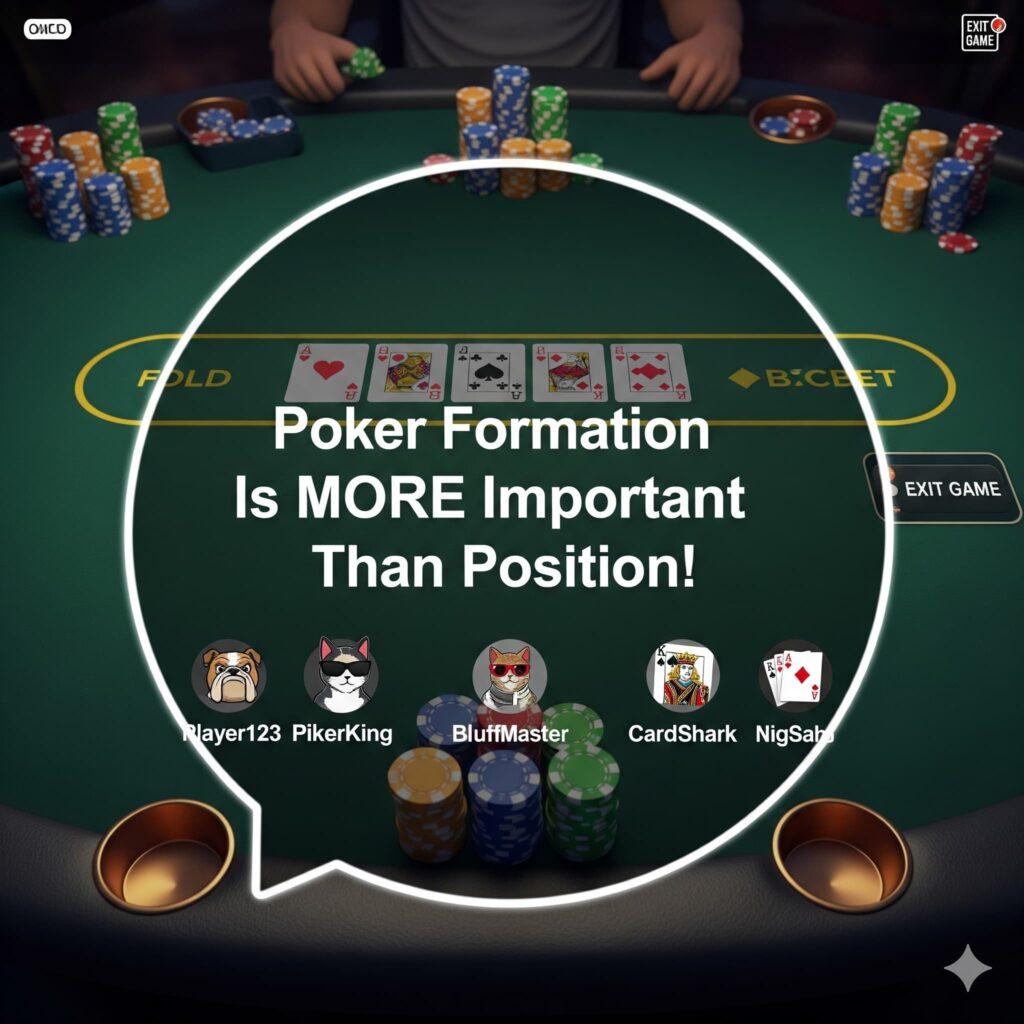For years, poker coaches have drilled a simple concept into our heads: “Position is everything.” We’re taught to categorize every spot as either “in position” or “out of position.” While that’s not wrong, it’s a massive oversimplification. According to a recent Red Chip Poker podcast episode, this binary approach misses the critical nuance that separates good players from elite ones. The key to unlocking a higher level of strategy isn’t just position; it’s
formation.
Thinking that strategy should be based simply on being “in position” or “out of position” is an overly broad and weak approach. The precise table formation has a very significant impact on the correct strategy, yet it is an often-overlooked variable. Let’s dive into why focusing on formation will fundamentally change the way you see the game.

Position vs. Formation: A Crucial Distinction
First, let’s clarify the terms, as their specificity is the core of this concept.
- Position: This generally refers to a binary state. You are either “in position” (acting after your opponent post-flop) or “out of position” (acting before your opponent).
- Formation: This is far more specific. It refers to the precise table positions involved in the hand. We’re no longer talking about “in position”; we’re talking about “button versus big blind,” “hijack versus lojack,” or “cutoff versus hijack”. Formations can also be grouped into broader categories like “early position formation,” “mid-position formation” (involving the cutoff), and “late position formation” (cutoff or later).
This shift from a general concept to a specific one is what allows for a more refined and powerful strategy.
The GTO Proof: How Formation Radically Changes Correct Play
If you think a single “in position” c-betting strategy is sufficient, solver data proves otherwise. The correct theoretical play changes dramatically based on the specific players involved, even when all other variables seem constant.
C-Betting Frequencies in 3-Bet Pots
Let’s look at a standard in-position, three-bet pot. A generalized strategy doesn’t work because the optimal c-bet frequency swings wildly depending on the formation.
- In a Big Blind vs. Small Blind formation, the c-bet frequency is around 61.7%, one of the lowest in this spot.
- When the formation is Button vs. Cutoff, the frequency skyrockets to about 82.4%.
- In the earliest possible formation, Hijack vs. LoJack, the frequency climbs even higher to 84%.
The pattern is clear: the earlier the formation, the more aggressively you should be c-betting. The same is true for out-of-position play, where a
Small Blind vs. Button formation has a noticeably higher c-bet frequency (~71.3%) than a Big Blind vs. Button formation (~63.4%) because of differences in their pre-flop ranges.
Flop Overbetting Strategy
The impact of formation becomes even more extreme when looking at overbets. On a Jack-Four-Rainbow flop, the GTO frequency for an overbet c-bet changes drastically.
- Button vs. Big Blind (late position formation): The solver overbets 30% of the time.
- Cutoff vs. Big Blind (mid-position formation): The frequency drops sharply to 18.6%.
- Hijack vs. Big Blind (early position formation): The frequency plummets to just 1.9%.
- LoJack vs. Big Blind: The frequency is almost nonexistent at 0.5%.
These strategic shifts are so extreme that the cutoff is considered its own unique formation. The difference is also apparent when the opponent changes; a
Button vs. Small Blind encounter shows an overbet frequency of 9.2%, vastly different from the 30% seen in Button vs. Big Blind, because the small and big blinds have very different cold-calling ranges.
Using Formation to Sharpen Your Exploitative Play
This concept isn’t just for GTO wizards; it’s essential for exploitative poker. Analyzing your opponents’ stats by formation is far more useful than looking at their overall averages.
- Bluffing Frequencies: Opponents are much more likely to bluff or over-bluff in late position formations. Their ranges are wider, meaning they show up with more “natural bluffs” that can’t win at showdown. Conversely, in early position formations, their ranges are stronger and contain fewer natural bluffs, leading to lower bluffing frequencies.
- Folding Frequencies: For the same reason, opponents are more likely to fold to aggression in late position formations because their ranges simply contain more “air”. In early position formations, their stronger hand distributions mean they have more bluff-catchers and strong made hands, causing them to fold less often.
By ignoring formation, you could miss highly profitable opportunities. A bluff-raise that seems breakeven on average might be a massive money-maker in a specific late position formation where your opponent is likely to over-fold.
Conclusion: It’s Time to Think in Formations
The evidence is overwhelming. Your strategy should change heavily according to formation because it dictates the pre-flop ranges for both you and your opponent. These range differences fundamentally alter the correct theoretical and exploitative approach to any given hand.
If you’re still just thinking “I’m in position, so I’ll c-bet,” you are leaving money on the table. Start analyzing hands by their specific formation—Button vs. Big Blind, Cutoff vs. Hijack, and so on—and you will discover a more precise and profitable way to navigate every street.
